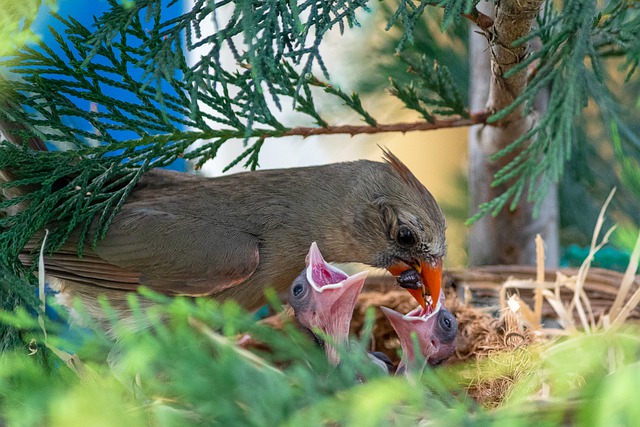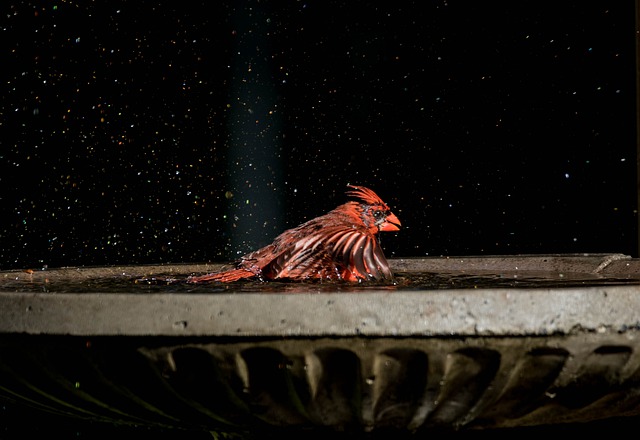Cardinals are a beautiful and common bird that may be found in densely forested places such as woodlands, hedgerows, overgrown meadows, and backyards.
They are medium-sized to giant songbirds that frequently visit backyard bird feeders.
Cardinals are known for their brilliant blue, red, or yellow coloring, which is frequently observed in breeding males.
It’s thrilling to find bird eggs or observe baby birds of any type in your yard, but it’s much more amazing if they’re cardinal babies or eggs.
Whether you have cardinals in your yard and want to know if and when they lay eggs, this article will tell you all you need to know.
When Do Cardinals Lay Eggs?

Female Cardinal have a protracted mating season. They may lay their eggs from February to September, which is far longer than many other wild birds.
Because Cardinals do not migrate, they can enjoy a longer mating season, giving them more time and energy to reproduce and care for their young.
Cardinals can have two to four broods every season, each with up to five eggs. This implies that a single female cardinal bird may lay more than 20 eggs in a single season, allowing the number of cardinal birds in your garden to expand during the season rapidly.
Cardinal nests are around 4′′ by 3′′ in size and are formed of twigs, bark, leaves, and grass stem by female cardinals. Cardinal birds seldom use the same nest again, and once one brood has left the nest, the female cardinal bird will start seeking the next one.
The female cardinal adjusts her nest-building strategy according to the season and temperature. In the spring, the mother cardinal will build extra insulation to the nest, which will help her kids survive in the lower temperatures.
In the summer, the mother cardinal will incorporate less insulation since the young may overheat in the hot temperatures. When looking for a place to build her next nest, the female cardinal will look at a variety of options.
They’ll be seeking regions that are secure from predators first, and camouflage will be crucial. Nesting sites are typically found on the outskirts of woodland regions or in thick bushes, hedges, or vegetation.
Surprisingly, the position of the nest varies depending on the season in which the brood occurs. The female cardinal birds choose nesting sites that are closer to the ground for the first brood of the season.
Female cardinal birds prefer higher-up nesting places as the season progresses and the foliage grows denser. Cardinal bird nests, on the other hand, are still modest in comparison to other birds, at around 4 to 8 feet from the ground.
It’s a good idea to have some undergrowth along the margins of your yard if you want to attract cardinal birds to nest there. This will provide the nest with the necessary protection.
Outside of the mating season, female cardinals join big flocks and forage with the new flock for food and water. They like to stay near to the location where they spend their mating season in general.
The female cardinal bird will then mate with her mate from the previous year or find a new one when January and February arrive and begin the breeding process from the beginning.
What Time of the Year Do Cardinals Lay Eggs?
Cardinals lay eggs from March to September, with the chickens producing eggs twice or three times throughout that time. While the female builds the nest, the male keeps a tight check on her and the surrounding region for predators.
They lay eggs between two and three times a year, as previously indicated.
Each time the female lays eggs, she will lay 3 or 4 eggs. They have a whitish-green hue and take 11 to 13 days to hatch.
Overview of Cardinal Nesting

Cardinal birds are a popular species, yet despite their popularity, many people don’t know much about them or their nesting and breeding habits.
This article is very useful since it describes the nesting and developing process of young cardinal birds.
The following is a good summary of the relevant information:
- Each season, there are 2 – 4 broods.
- The breeding season is from February through September.
- March to August is the nesting season.
- The number of eggs in each brood varies from one to five.
- Seasonal Egg Production: Up to 20
- Description of the egg: It is approximately 1 inch long and 0.75 inches broad.
- Light gray, white, or light green are some of the hues available, with gray or brown specks.
- Period of incubation: 12 – 13 days
Cardinal Egg’s Color and Size

Cardinal eggs come in a wide range of colors and patterns, just like cardinals. From brood to brood, the same female cardinal bird can lay various colored eggs. Each brood, however, will have eggs of the same hue.
When compared to the cardinal birds themselves, cardinal eggs are far more muted in color. Light gray with brown or gray speckles, light green with brown or gray speckles, and ivory with brown or gray speckles are all possible hues for cardinal bird eggs.
Cardinal bird eggs are around 1 inch long and 0.75 inches broad. This puts them on par with Brown Thrashers in terms of egg size.
Do Cardinals Lay Their Eggs in the Same Nest Year After Year?

The answer, as per research published by Candor, is yes. When a cardinal pair establishes a territory, researchers discovered that they frequently return to the same nesting place year after year to lay eggs.
Many animals do return to the same location year after year, but this is not true for all of them. During the nesting breeding season, for example, certain bird species will breed at the same location each year. Birds that utilize this method include the blue jay and the robin.
Why Do Cardinals Use the Same Nest Over and Over for Laying an Egg?
Cardinals return to their old nests for a variety of reasons. The first reason is that cardinals are monogamous and wish to safeguard their lands.
Every year, a male cardinal will construct a new nesting location. If he constructs his birdhouse near the territory of another male, the other male may attack him.
Cardinals lay two eggs in each clutch, and they can conserve resources by not building a new nest if they reuse an existing one.
Finally, cardinals reuse their nests in the winter because it keeps them warm.
The Cardinals don’t have to create as much heat by breeding in a location where there is already warmth from the sun or fire.
Which Cardinals are Likely to Return to the Same Roost?

Many types of cardinal birds return to the same nest year after year. The American robin, red-winged blackbird, and purple martin are among these birds.
Some cardinal species, such as the Blue Jay, do not migrate and return year after year to the same nest. Other species, such as the Red Cardinal may move considerable distances and never return to their native breeding grounds.
Cardinal birds are monogamous and make their nests in trees or high places when they’ve found a suitable spot. Small materials such as twigs, leaves, and other small bits of wood will be collected by the male cardinal as he begins to build the nest.
He will add new materials to the nest after it is complete, such as soft bedding materials like down or feathers. The female cardinal will then enter the nest and lay her eggs.
Around six weeks after hatching, the young cardinals will fledge the nest and begin exploring other places to make their nests.
Conclusion
So this is all from us about when do the cardinals lay Eggs? About two to three times a year, female cardinals lay eggs. Females lay between one and five eggs in each brood.
The eggs are speckled blue, green, or gray all throughout and have a smooth white glossy look.
They’re 1 inch long and 0.8 inches wide. Because these eggs take around 11 to 13 days to incubate, the females devote roughly the same amount of time to them.
FAQ
Is it true that cardinals only lay one egg?
The female will lay 3 or 4 eggs each time. They are pale green in hue and may be incubated for anywhere from 11 to 13 days.
During the incubation period, the male gets food and delivers it to his spouse. Mother looks after the cardinal chicks after they hatch and throughout the first few days of their existence.
What does it look like when a cardinal lays eggs?
Cardinal eggs are glossy and gleaming. They range in color from white to pale blue or greenish-white and are speckled with brown, purple, or gray flecks.
The eggs are about 1 inch long and 3/4 inch wide. Cardinals produce eggs in batches of two to five once or twice a year.
How long does it take a cardinal to lay an egg?
The female lays 2-5 eggs each time, which hatch approximately 11-13 days after she lays them. Cardinal babies develop quickly and are generally out of the nest in 9-11 days.
Last Updated on March 22, 2023 by Lily Aldrin
